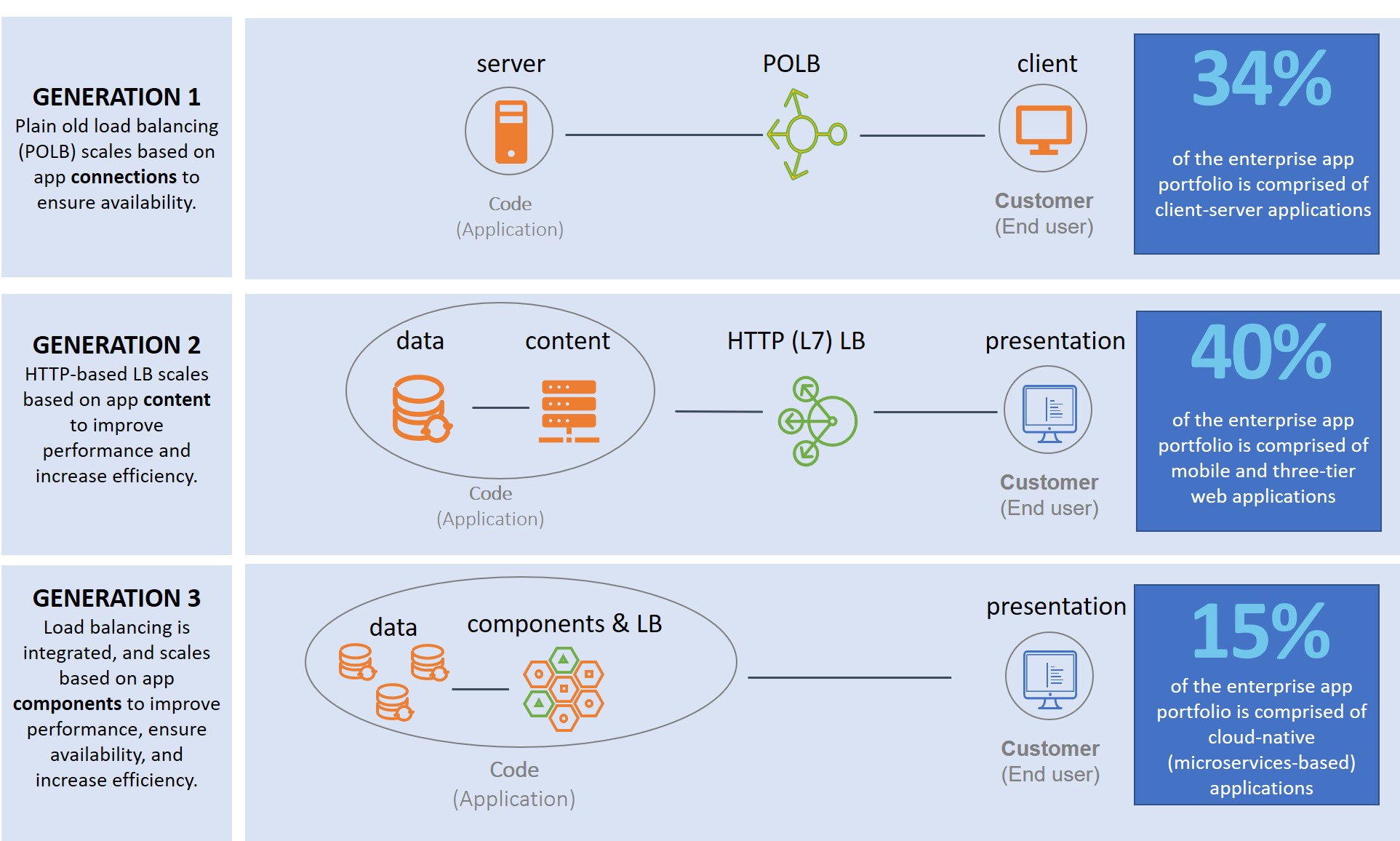로드 밸런싱의 진화는 애플리케이션 아키텍처와 연결되어 있습니다.


새로운 세대의 애플리케이션 아키텍처가 발전함에 따라 새로운 세대의 로드 밸런싱도 함께 발전한다는 것은 놀라운 일이 아닙니다. 세기가 바뀌기 직전에 로드 밸런싱이 처음 등장한 이래로 이 기술은 예측 가능한 속도로 발전해 왔으며, 이는 혁신이 필요한 시점이라는 것을 의미합니다.
오늘날 우리는 5세대 애플리케이션 아키텍처 의 도입이 급속히 가속화되는 모습을 보고 있습니다. 클라우드 네이티브(마이크로서비스 기반) 애플리케이션의 성장은 예상보다 빠르게 진행되고 있습니다. 최신 Stackrox 컨테이너 및 Kubernetes 보안 연구에 따르면 응답자의 약 30%가 애플리케이션의 절반 이상을 컨테이너화한 것으로 나타났습니다.
또한, 애플리케이션을 복합적인 비즈니스 기능으로 분리함으로써 발생하는 작업 부하도 증가합니다. 이러한 해체는 소비자에게 디지털 기능을 제공하는 속도에 대한 욕구에 의해 주도됩니다. 비즈니스 기능의 범위를 줄임으로써 각 기능을 다른 비즈니스 기능에 큰 영향을 미치지 않고 독립적으로 개발, 테스트 및 제공할 수 있습니다. 이를 통해 기업은 새로운 디지털 기능을 더 빠르고 더 자주 제공함으로써 규모를 더 빠르게 확장할 수 있습니다. 결과적으로 하나의 애플리케이션은 이제 5개 이상의 워크로드로 구성되었으며, 각각은 컨테이너화되고 자체적으로 확장됩니다.
현대 건축에서는 이러한 전통적인 층이 여러 구성요소로 분해되었습니다. 최신 애플리케이션의 80% 이상은 외부에서 조달한 구성 요소로 구성됩니다. 프레젠테이션 프레임워크, 로컬 데이터, 세션 데이터, 트랜잭션 데이터. 심지어 논리마저도 찢겨져 개별 비즈니스 기능을 나타내는 작업 부하에 분산되었습니다.
단일 애플리케이션이 여러 기능으로 분할되면 동서 트래픽이 증가합니다. API에 대한 의존도가 높기 때문에 추가적인 확장, 최적화 및 저지연 액세스가 필요합니다. 부하 분산은 여전히 그 확장을 달성하는 주요 수단입니다. 하지만 항상 전통적인 프록시를 통해 전달되는 것은 아닙니다. 오늘날 데이터 경로는 더 복잡하고 역동적입니다. 이로 인해 확장되는 작업 부하만큼 분산되는 새로운 세대의 로드 밸런싱이 탄생했습니다.

부하 분산은 환경 변화에 대처하기 위해 발전하고 있으며, F5에서는 애플리케이션에 중점을 둡니다.
로드 밸런싱을 따르는 새로운 세대의 애플리케이션 서비스
보안과 같은 애플리케이션 서비스도 부하 분산을 거쳐 새로운 분산 모델로 전환되는 것을 볼 수 있는데, 이는 보안을 담당하는 애플리케이션이 분산되었기 때문입니다. 이 모델에서 마이크로서비스(구성 요소) 수준의 보안 및 확장성은 컨테이너 간 보안 및 확장성과 유사합니다. 따라서 Kubernetes 클러스터와 관련된 서비스 메시가 증가하고 있습니다. 서비스 메시는 안전하고 확장 가능한 컨테이너 간 통신에 대한 필요성을 해결하기 위해 고안되었습니다.
우리는 서비스 메시의 요구와 필요성이 변화하는 것을 봅니다. 이러한 현상이 계속해서 성장함에 따라 어려움이 없는 것은 아닙니다. 복잡성은 컨테이너를 개발, 배포 및 운영하는 사람들에게 여전히 큰 과제로 남아 있습니다. 즉, Reflex 의 연구에 따르면 응답자의 거의 절반(43%)이 프로덕션 환경에서 컨테이너를 실행하는 데 있어 가장 큰 과제로 "복잡성"을 꼽았습니다.
이러한 과제는 다양한 역할이 이 새로운 세대의 로드 밸런싱 및 애플리케이션 서비스를 배포하고 운영할 수 있도록 하는 관리(제어) 계층을 통해 해결되어야 합니다. F5는 현대적 아키텍처와 환경의 복잡성에 압도당하지 않으면서도 규모에 맞춰 운영하는 문제를 해결할 수 있는 독특한 위치에 있습니다.
예를 들어, Kubernetes와 Istio 배포의 복잡성 문제를 해결하기 위해 Aspen Mesh를 제공합니다. 또한 우리는 최신 애플리케이션 배포를 제어하고 가시성을 제공하기 위해 NGINX의 힘을 기반으로 한 솔루션도 개발하고 있습니다.
로드 밸런싱에 이어 최신 애플리케이션 아키텍처가 도입되면서 보안 및 가시성과 같은 애플리케이션 서비스에 혁신적 효과가 계속될 것입니다. F5의 경우, 이는 상자 밖의 사고방식을 취하고 컨테이너 클러스터 내부를 살펴보는 것을 의미합니다.